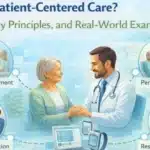Advanced Primary Care Management: Transforming Healthcare Delivery for Better Outcomes

Primary care is the foundation of a strong healthcare system; however, it is struggling to meet the needs of patients in the United States. According to the American Academy of Family Physicians, nearly one in four adults do not have a regular primary care provider. Even more surprisingly, the Commonwealth Fund reports that despite spending more per capita on healthcare than any other country, the United States ranks last among 11 high-income countries in access to primary care.
The Centers for Disease Control (CDC) reports that 90% of the nation’s $4.1 trillion annual healthcare expenditures are attributed to chronic conditions like diabetes, heart disease, and hypertension. So, with the right care model, these illnesses become manageable and/or preventable. This is where Advanced Primary Care Management (APCM) comes in
Table of Contents
ToggleWhat is Advanced Primary Care Management (APCM)?
APCM is a healthcare model that aims to improve how primary care is delivered and managed. It builds on traditional primary care by adding proactive, team-based, and data-driven approaches to better meet patient needs, especially in complex and high-risk populations.
By combining a proactive, tech-enabled, and holistic approach, Advanced Primary Care Management prioritizes the needs of each patient while optimizing procedures and empowering healthcare professionals to provide better care.
The key technologies that empower APCM are as follows:
- Electronic Health Records (EHRs),
- Population health tools
- Telehealth to improve care delivery
- Care management software
- Clinical decision support
- Patient portals which help teams coordinate care and engage patients
- Data analytics to track outcomes
- Remote monitoring and interoperability platforms support proactive, connected, and continuous care.
Advanced Primary Care Management’s Objectives
Advanced Primary Care Management aims to improve access to care through timely appointments and virtual options, while enhancing care quality using data and evidence-based practices. APCM use cases focuses on building strong patient-provider relationships, coordinating care across settings, and emphasizing prevention and early intervention.
APCM also leverages technology to guide clinical decisions, supports providers through efficient workflows and value-based incentives, and works to advance health equity by addressing Social Determinants of Health (SDoH).
Also Read: Advanced Primary Care Management (APCM) Use Cases in Remote Healthcare
Service Elements For Advanced Primary Care Management
- Patient Consent: While all Medicare patients are eligible for Advanced Primary Care Management services, they must provide consent or sign an agreement before receiving care. Patients must provide written consent to participate in APCM. They cannot enroll in APCM while already enrolled in other care management programs such as Chronic Care Management (CCM) or Principal Care Management (PCM). Patients must also agree to cost-sharing unless they are a Qualified Medicare Beneficiary. QMBs are exempt from copayments and deductibles.
- Initiating Visit for New Patients: New patients must have an initial visit, however, it is not required if the patient has seen the provider or another provider at the practice within the last three years. An initial visit is also not required if the recipient has received CCM or PCM services from their physician or another provider in the same practice within the previous year.
- 24/7 Access to Care: APCM services are provided 24 hours a day, seven days a week, and a member of the care team with access to the patient’s health records must always be available. The patient should be able to see the same member of the care team for future routine sessions, and the practice should offer convenient alternatives to traditional office visits, such as extended clinical practice hours or home visits.
- Comprehensive Care Management: This includes analyzing patients’ physical and psychosocial requirements. This ensures that patients receive preventive care, medication management assistance, and self-care support.
- Comprehensive Care Plan: Advanced Primary Care Management is a patient-centered care delivery paradigm. Care coordinators collaborate with patients to develop, implement, amend, and maintain an effective care plan in electronic format. This document must be accessible to all parties involved in a patient’s care, including the provider, the care team, and the patient’s family or caregiver(s).
- Care Transition Management: Care providers are responsible for ensuring that patients transfer from one healthcare environment to another. Whether the patient has been referred to a specialist, discharged from the hospital, or returned home following an emergency visit, the care provider is responsible for ensuring continuity of treatment. The care provider/manager must share electronic information on the care plan and transition with other clinicians involved in the patient’s care, as well as communicate with the patient within seven days after being discharged from the practice or healthcare facility.
- Care Coordination: Care providers must assist patients in locating and obtaining services from practitioners, home-based care providers, community-based services, social service organizations, hospitals, and skilled nursing facilities as needed. They must also document the patients’ psychosocial strengths, needs, and outcomes, taking into account their cultural and linguistic preferences.
- Improved Contact: Advanced Primary Care Management simplifies patient-provider contact by secure messaging, email, Internet, patient portal, or phone. Providers should also be able to discuss, assess, and evaluate patient-provided pre-recorded media, such as photos or videos. Healthcare practitioners must be able to offer patients digital communication options such as virtual check-ins and e-visits.
- Patient Population-Level Management: Practices must analyze patient data to identify gaps in treatment and implement timely interventions. They must also be able to risk-stratify their patients utilizing the three proposed levels of APCM, which are GPCM1 (Level 1), GPCM2 (Level 2), and GPCM3.
- Performance Measurement: APCM prioritizes outcome-based treatment, setting it apart from other care programs. Practitioners who qualify for the MIPS program must sign up for the Value in Primary Care MIPS Value Pathway. APCM is also available to providers who engage in other Medicare programs, like ACO Reach and Primary Care First.
Benefits of Advanced Primary Care Management
Organizations that have opted for APCM have experienced exceptional results in clinical outcomes, patient satisfaction, cost reduction, and provider participation. For example, the chronic disease control rate rose by 20 to 30%, while emergency room visits and hospital readmissions went down sharply by 22%. Add how much they have gone down by.
- Patient Satisfaction: Patients report higher levels of satisfaction, improved personalized care, shorter wait times, and better communication with care teams. Net Promoter Scores (NPS), a measure of customer satisfaction, tend to be two to three times higher than those in traditional care.
- Cost Reduction: Organizations that implemented APCM witnessed a reduction in the amount of money they spent on healthcare. According to the National Business Group on Health report, APCM implementations have seen up to 15% reductions in total medical costs.
- Provider Satisfaction: APCM offers providers a much more satisfying workplace with less burnout and better working relationships, thereby improving staff retention and boosting morale.
The Future of Advanced Primary Care Management
The path ahead for advanced primary care management will continue to be influenced by new technologies and the changing healthcare landscape. In the near future, we should expect to see more digitized, AI-driven personalization with predictive models and digital platforms.
The care plans adopted will likely have genomic data embedded into them, allowing for precision and accuracy. We also may see systemic shifts toward national payment reforms, with bundled and capitated payments gaining ground.
Conclusion: HealthArc is Helping Transform Advanced Primary Care Management
As healthcare shifts from volume- to value-based models, providers need a comprehensive platform to support Advanced Primary Care Management. HealthArc leads this shift with a unified, user-friendly system that integrates RPM, CCM, BHI, TCM, and predictive analytics. With seamless EHR integration, automated documentation, and configurable workflows, HealthArc improves care coordination and delivers real-time population insights.
By aligning with value-based goals, it helps providers reduce costs, boost engagement, and improve outcomes. Schedule a free demo to see how HealthArc can strengthen your APCM program.
Frequently Asked Questions (FAQs)
Advanced Primary Care Management is a more proactive, team-based, and technology-focused model than traditional care models. The main difference is that APCM focuses on prevention, care coordination, and patient engagement while traditional care focuses mainly on visit-based care.
HealthArc is an all-in-one digital health platform that provides several technologies including Remote Patient Monitoring, Care Coordination, and Predictive Analytics to ensure that providers are delivering efficient, personalized, data-driven, and actionable care.
Chronic diseases, such as diabetes, hypertension, heart disease, obesity and COPD should be managed under APCM, as they require ongoing monitoring, early intervention, and a lifestyle approach to management.
Yes! APCM is scalable, and small clinics can adopt APCM with platforms such as HealthArc offering customizable workflows and seamless integrations.
Many APCM services, including RPM and CCM, are reimbursed under Medicare, and most private insurers reimburse care under value-based care models.
References
Commonwealth Fund
“The U.S. ranks last in access among 11 high-income countries despite highest healthcare spending.”
U.S. Health Care from a Global Perspective, 2019
Centers for Disease Control and Prevention (CDC)
“90% of the nation’s $4.1 trillion healthcare spend goes to chronic diseases.”
About Chronic Diseases – CDC
Centers for Medicare & Medicaid Services (CMS)
“Details on APCM patient consent, initiating visits, 24/7 access, and care coordination.”
CMS – Care Management Services
Health Affairs Journal
“Insights on creating ideal systems with Advanced Primary Care.”
Advanced Primary Care: Creating the Ideal Health Care System
Most Recent Blogs
Categories
Related Blog
- November 27, 2025 | Read Time: 13 mins
Advanced Primary Care Management (APCM): A Complete Guide for Medicare‑Focused Practices
Advanced primary care management (APCM) is Medicare’s new, population‑based care management framework...
Learn More- October 9, 2025 | Read Time: 45 mins
Advanced Primary Care Management (APCM): What Hospitals and FQHCs Need to Know in 2025
In 2025, the Centers for Medicare & Medicaid Services (CMS) introduced significant...
Learn More- July 19, 2025 | Read Time: 19 mins
Advanced Primary Care Management (APCM): What Providers Need to Know?
Primary care is a thing of the past, often addressed as an...
Learn More


